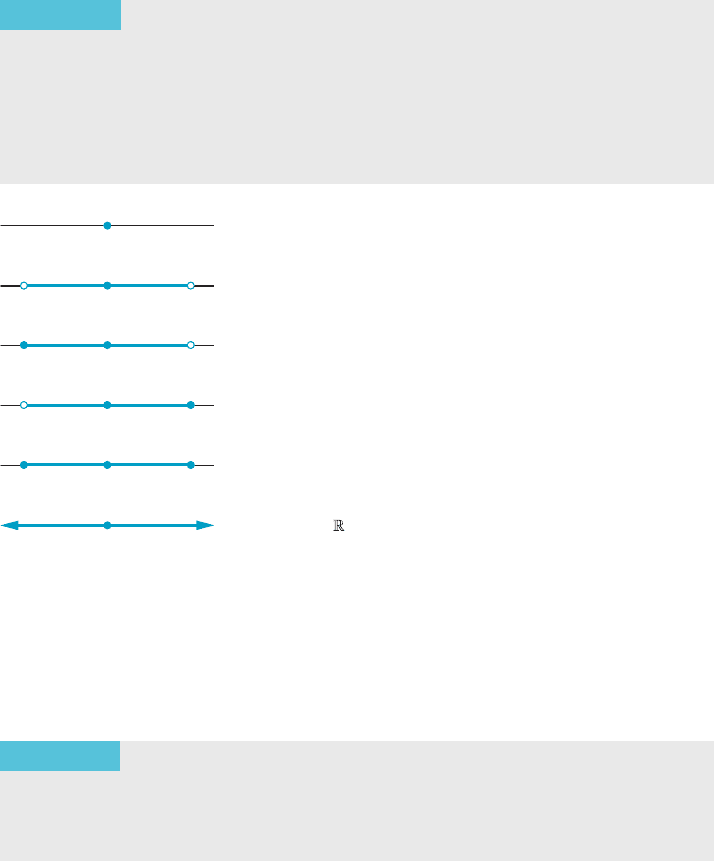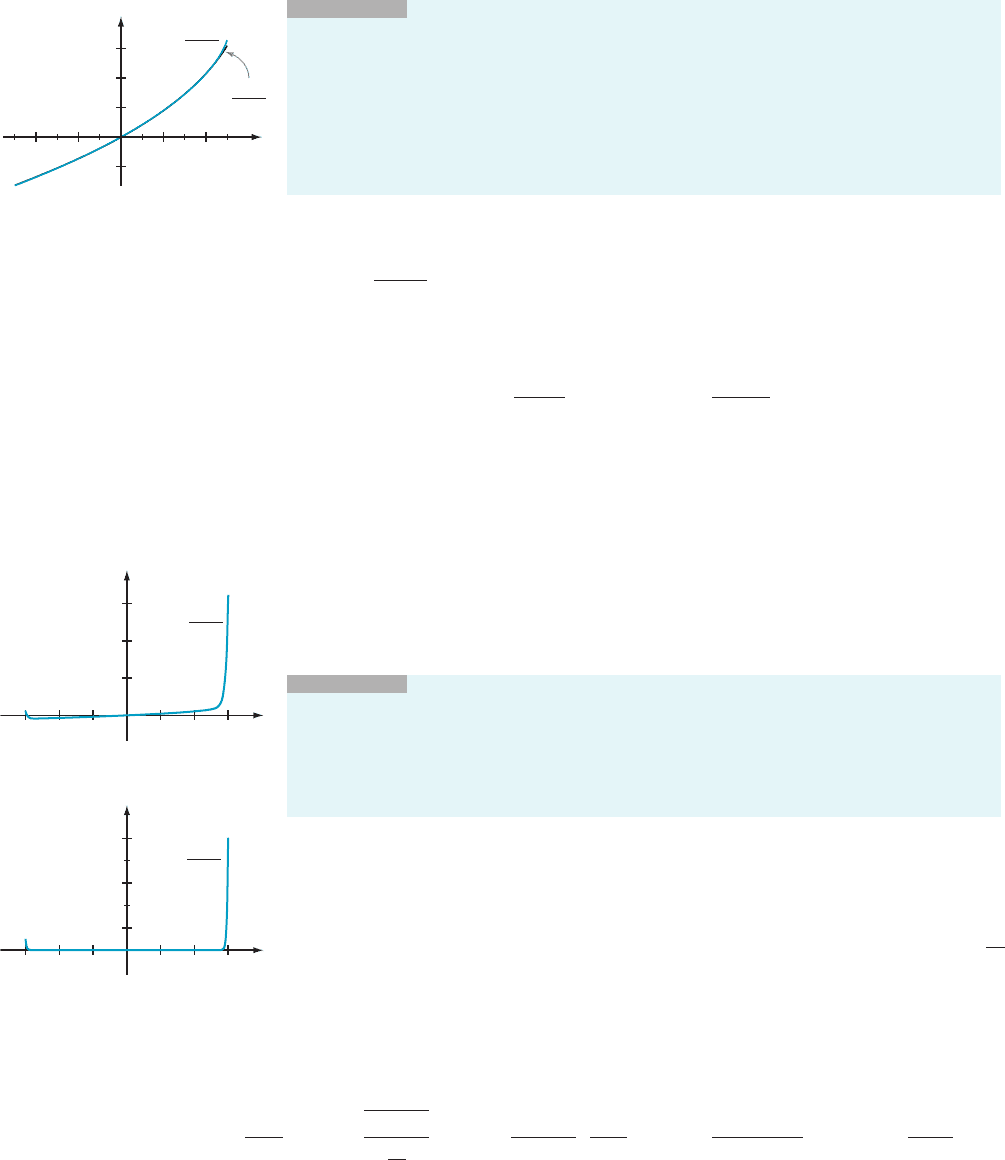Blank B.E., Krantz S.G. Calculus: Single Variable
Подождите немного. Документ загружается.


by comparison with the convergent geometric series
P
N
n50
r
n
. In summary, we have
proved that if a power series
P
N
n50
a
n
x
n
converges at some value of x, then it
converges absolutely at all points that have a smaller absolute value. It follows that
the set of points where the series converges is an interval centered at the origin.
This interval can have infinite length, finite positive length, or zero length (see
Figure 1). We state this as the following theorem.
THEOREM 1
Let
P
N
n50
a
n
x
n
be a power series. Then precisely one of the fol-
lowing statements holds:
a. The series converges absolutely for every real x.
b. There is a positive number R such that the series converges absolutely for
jxj, R and diverges for jxj. R.
c. The series converges only at x 5 0.
Whichever the case, there is a quantity R that is either a nonnegative real
number or 1N such that the power series
P
N
n50
a
n
x
n
converges absolutely for
jxj, R and diverges for jxj. R. In case a of Theorem 1, R 5Nand in case c, R 5 0.
In all cases, we say that R is the radius of convergence of the power series. We now
learn how to compute this quantity.
THEOREM 2
Suppose that the limit ‘ 5 lim
n-N
ja
n
j
1=n
exists (as a nonnegative
real number orN). Let R denote the radius of convergence of the power series
P
N
n50
a
n
x
n
.If0, ‘ ,N, then R 5 1/‘.If‘ 5 0, then R 5N, and if ‘ 5N, then
R 5 0.
Proof. The
Root Test (Section 8.5) applied to
P
N
n50
a
n
x
n
tells us the series converges
absolutely when L 5 lim
n-N
ja
n
x
n
j
1=n
, 1 and diverges when L 5 lim
n-N
ja
n
x
n
j
1=n
. 1.
Notice that L 5 jx jlim
n-N
ja
n
j
1=n
5 jxj‘. Thus the series converges absolutely for
jxj‘ , 1 ð8:6:1Þ
0
0 RR
Single point {0}
Open interval (R, R)
Left-closed, right-open interval [R, R)
Left-open, right-closed interval (R, R]
Closed interval [R, R]
Entire real line
0 RR
0 RR
0 RR
0
m Figure 1 Intervals of convergence.
8.6 Introduction to Power Series 675

and diverges for
jxj‘ . 1: ð8:6:2Þ
If ‘ 5 0, then inequality (8.6.1) is satisfied for all x. Consequently R equalsN.If‘ 5N,
then inequality (8.6.2) is satisfied for all x 6¼0, and therefore R 5 0. If ‘ is finite an d
positive, then the series converges for jxj, 1/‘ and diverges for jxj. 1/‘. This means
that R 5 1/‘. ’
DEFINITION
The set of points at which a power series
P
N
n51
a
n
x
n
converges is
called the interval of convergence.
If R 5N, then the interval of convergence is the entire real line. If R 5 0, then
the interval of convergence is the single point {0}. When 0 , R ,N, the series
converges on the interval (2R, R) but it may or may not conve rge at the endpoints
x 5 R and x 52R. To determine the interval of convergence, each endpoint must
be tested separately by substituting the values x 5 R and x 52R into the series.
Thus when R is positive and finite, the interval of convergence will have the form
[2R, R]or(2R, R]or[2R, R)or(2R, R), as shown earlier in Figure 1.
⁄ EX
AMPLE 3 Find the interval of convergence for the power series
X
N
n50
x
3
n
.
Solution With a
n
5 1/3
n
, we calculate
‘ 5 lim
n-N
ja
n
j
1=n
5 lim
n-N
1
3
n
1=n
5 lim
n-N
1
3
5
1
3
:
The radius of convergence R is the reciprocal of ‘. Thus R 5 3. This tells us that the
series converges (absolutely) when j x j, 3 and diverges when jxj. 3. To completely
determine the interval of convergence, we must investigate each endpoint. When
x 5 3, the series becomes
P
N
n50
1, which diverges. When x 523, the series becomes
P
N
n50
ð21Þ
n
, which also diverges. The interval of convergence is therefore (23, 3).
As a function of x, the domain of the power series
P
N
n50
x
n
=3
n
is the open interval
(23, 3).
¥
⁄ EXAMPLE 4 Find the interval of convergence for the series
P
N
n51
x
n
=n.
Solution We
set a
n
5 1/n and calculate
‘ 5 lim
n-N
ja
n
j
1=n
5 lim
n-N
1
n
1=n
5 lim
n-N
1
n
1=n
5
ð8:5:1Þ
1:
The radius of convergence R is given by R 5 1/‘ 5 1. Thus the series converges
(absolutely) for jxj, 1 and diverges when jxj. 1. When x 5 1 the series becomes
P
N
n51
1=n; this is the harmonic series, which diverges. When x 521, the series
becomes
P
N
n51
ð21Þ
n
=n, which is convergent by the Alternating Series Test. We
conclude that the interval of convergence is [21, 1). The power series
P
N
n51
x
n
=n
defines a function of x with domain [21, 1).
¥
676 Chapter
8 Infinite Series

INSIGHT
We know from Theorem 1 that convergence is absolute at any point of the
interval of convergence other than an endpoint. Nevertheless, the definition of “interval
of convergence” refers only to convergence—not absolute convergence. If R 2(0,N)is
the radius of convergence of a power series
P
N
n50
a
n
x
n
and if the series converges when
x 5 R, then R is in the interval of convergence whether the convergence is conditional or
absolute. The same statement holds for 2R. Thus in Example 4, the endpoint 21 belongs
to the interval of convergence of
P
N
n51
x
n
=n even though
P
N
n51
x
n
=n converges con-
ditionally when x 521.
⁄ EXAMPLE 5 Find the radius and interval of convergence for the power
series
X
N
n51
x
n
5
n
n
2
.
Solution Let a
n
5 1/(5
n
n
2
). Then the radius of convergence R is given by
R 5
lim
n-N
ja
n
j
1=n
21
5
lim
n-N
1
5
n
n
2
1=n
21
5
lim
n-N
1
5 n
2=n
21
5 5 lim
n-N
ðn
1=n
Þ
2
5
ð8:5:1Þ
5:
Thus the series converges (absolutely) when jxj, 5 and diverges when jxj. 5.
When x 5 5, the series becomes
P
N
n51
1=n
2
, which is a convergent p-series. When
x 525, the series becomes
P
N
n51
ð21Þ
n
=n
2
, which, by the Alternating Series Test,
also converges. We conclude that the interval of convergence is [25, 5]. The power
series
P
N
n51
x
n
=ð5
n
n
2
Þ therefore defines a function with domain [25, 5]. This
function is plotted in Figure 2. The graph of the approximating partial sum,
P
10
n51
x
n
=ð5
n
n
2
Þ, is also shown in the figure. The approximating curve and the
original curve are so close that they are difficult to distinguish.
¥
INSIGHT
Graphing some partial sums of a power series can provide clues to its
convergence properties. Example 5 shows that [25, 5] is the interval of convergence of
P
N
n51
x
n
=ð5
n
n
2
Þ. Figure 3 suggests the divergence outside this interval. In Figure 3a, the
partial sum
P
50
n51
x
n
=ð5
n
n
2
Þ is plotted over the interval [26, 6]. In Figure 3b, the partial
sum
P
100
n51
x
n
=ð5
n
n
2
Þ is plotted. Notice the scales on the vertical axes.
Sometimes it is convenient to use the Ratio Test when calculating the radius of
convergence. The next example will illustrate this technique.
⁄ EX
AMPLE 6 Find the interval of convergence for the power series
X
N
n50
x
n
n!
by using the Ratio Test.
Solution Acco
rding to the Ratio Test (Section 8.5), the series
P
N
n51
u
n
converges
absolutely if lim
n-N
ju
n11
=u
n
j, 1 and diverges if lim
n-N
ju
n11
=u
n
j. 1. We set
u
n
5 x
n
/n! and calculate
lim
n-N
u
n11
u
n
5 lim
n-N
x
n11
ðn 1 1Þ !
x
n
n!
5 lim
n-N
n!
ðn 1 1Þ!
x
n11
x
n
5 lim
n-N
n!
ðn 1 1Þn!
x
5 lim
n-N
x
n 1 1
5 0:
1.5
1.0
0.5
244
y
x
0.5
x
n
5
n
n
2
n 1
x
n
10
5
n
n
2
n 1
m Figure 2
66442
10
20
30
2
x
y
x
n
50
5
n
n
2
n 1
m Figure 3a
66442
10000
30000
50000
2
x
y
x
n
100
5
n
n
2
n 1
m Figure 3b
8.6 Introduction to Power Series 677

In particular, the limit is always less than 1. Hence, the Ratio Test tells us that the
series converges absolutely for every real x. In other words, R 5N, and the interval
of convergence is (2N,N).
¥
INSIGHT
Remember that a ratio of factorials can be simplified by peeling off factors
from the larger factorial until both numerator and denominator involve the same
factorial (which is then canceled). Example 6 illustrates this technique, as does the
next example.
⁄ EXAMPLE 7 Find the radius and interval of convergence for the series
X
N
n51
ð2nÞ!
n!
x
n
.
Solution We
set u
n
5 (2n)!x
n
/n! and calculate
lim
n-N
u
n11
u
n
5 lim
n-N
ð2n 1 2Þ!
ðn 1 1Þ!
x
n11
ð2nÞ!
n!
x
n
5 lim
n-N
ð2n 1 2Þ!
ð2nÞ!
n!
ðn 1 1Þ !
x
:
Because (n 1 1)! 5 (n 1 1) n! and (2n 1 2)! 5 (2 n 1 2)(2n 1 1) (2n)!, we have
lim
n-N
u
n11
u
n
5 lim
n-N
ð2n 1 2Þð2n 1 1Þð2nÞ!
ð2nÞ!
n!
ðn 1 1Þn!
x
5 lim
n-N
ð2n 1 2Þð2n 1 1Þ
ðn 1 1Þ
x
5 lim
n-N
j2ð2n 1 1Þ x j:
This limit is less than 1 only when x 5 0. It exceeds 1 (in fact the limit is infinite) for
any nonzero value of x. Therefore R 5 0, and the interval of conv ergence is the set
{0} that contains only the origin.
¥
The calculations that we have performed in Examples 6 and 7 can be gen-
eralized to yield another formula for the radius of convergence. We state this
formula now and indicate its derivation in Exercise 65.
THEOREM 3
Let R be the radius of convergence of the power series
P
N
n50
a
n
x
n
.
Suppose that
‘ 5 lim
n-N
ja
n11
j
ja
n
j
exists (as a nonnegative real number or N). If 0 , ‘ ,N, then R 5 1/‘.If‘ 5 0,
then R 5N.If‘ 5N, then R 5 0.
INSIGHT
Each of Theorems 2 and 3 gives a formula for the radius of convergence.
Which should be used? Naturally, when both limits exist, they must have the same value.
In courses on Advanced Calculus, it is shown that, of the two, the formula based on
the Root Test has wider scope. However, the formula based on the Ratio Test is
frequently easier to calculate. Therefore the Ratio Test is often tried first.
678 Chapter 8 Infinite Series

Power Series about an
Arbitrary Base Point
Often, it is useful to consider series that consist of powers of the form (x 2 c)
n
,
where c is any fixed constant. These series will have a radius of convergence R just
as before, but now the interval of convergence will be centered at the base point c.
(Until now, we have considered only power series centered at 0.) We will still have
to test the endpoints separately to determine the exact interval of convergence.
DEFINITION
Suppose that {a
n
} is a sequence of constants and that c is a real
number. An expression of the form
S 5 a
0
1 a
1
ðx 2 c Þ1 a
2
ðx 2 cÞ
2
1 a
3
ðx 2 cÞ
3
1
is called a power series in x with base point (or center) c.
It is convenient to denote the constant term a
0
of S by a
0
(x 2 c)
0
so that we may
write S as
P
N
n50
a
n
ðx 2 cÞ
n
. Notice that a power series with base point 0 is exactly
the sort of power series with which we have already been working. The next
theorem expresses the content of Theorems 1, 2, and 3 for an arbitrary base point.
THEOREM 4
Let fa
n
g
N
n50
be a sequence for which ‘ 5 lim
n-N
ja
n
j
1=n
exists as a
nonnegative real number or N. Then ‘ is also given by the formula
‘ 5 lim
n-N
ja
n11
j
ja
n
j
, if this limit exists. If 0 , ‘ ,N, set R 5 1/‘.If‘ 5 0, set R 5N.
If ‘ 5N, set R 5 0. Then
P
N
n50
a
n
ðx 2 cÞ
n
converges absolutely for fjx 2 cj, R }
and diverges for jx 2 cj. R. In particular, if R 5 N, then the series converges
absolutely for every real x.IfR 5 0, then the series converges only at x 5 c.
As with the case in which c 5 0, we call R the radius of convergence of the
power series. The set on which the series converges is called the interval of con-
vergence.IfR 5N, then the interval of convergence is the entire real line. If R 5 0,
then the interval of convergence is the single point {c}. When 0 , R ,N, the series
may or may not converge at the endpoints x 5 c 2 R and x 5 c 1 R. To determine
the interval of convergence, each endpoint must be tested separately by sub-
stituting the values x 5 c 2 R and x 5 c 1 R into the series. Thus when R is positive
and finite, the interval of conve rgence will have the form [c 2 R, c 1 R]or(c 2 R,
c 1 R]o
r[c 2 R, c 1 R)or(c 2 R, c 1 R). Figure 4 illustrates the possibilities.
⁄ EX
AMPLE 8 Calculate the interval of convergence for the power series
P
N
n50
ðx 2 2Þ
n
.
Solution Becau
se
P
N
n50
ðx 2 2Þ
n
5
P
N
n50
a
n
ðx 2 2Þ
n
with a
n
5 1 for all n,we
calculate ‘ 5 lim
n-N
ja
n
j
1=n
5 lim
n-N
1
1=n
5 1: We set R 5 1/‘ 5 1. Theorem 4 tells
us that the series converges (absolutely) for every x that satisfies jx 2 2j, 1and
diverges for every x such that jx 2 2j. 1. The points x 5 2 1 1 5 3 and x 5 2 2 1 5 1
must be tested separately. When x 5 3, the series becomes
P
N
n50
1
n
, which diver ges.
When x 5 1, the series becomes
P
N
n50
ð21Þ
n
, which also diverges. Thus the interval
of convergence is the open interval (1, 3).
¥
8.6 Introduction to Power Series 679

The final example involves several elemen ts of calculating the inte rval of
convergence of a power series. We first enumerate the steps.
Steps for Calculat ing an Interval of Convergence
1. Write the power series in the standard form
P
N
n50
a
n
ðx 2 cÞ
n
. In particular, the coefficient of x in the power
(x 2 c)
n
should be 1, and the base point c should be subtracted from x. To complete step 1, identify the center
c of the interval of convergence and the coefficient a
n
.
2. Calcul ate ‘ 5 lim
n-N
ja
n
j
1=n
or ‘ 5 lim
n-N
ja
n11
=a
n
j. To complete step 2, identify the radius of convergence
R.
If ‘ 5 0, then R 5N, and the interval of convergence is (2N,N). If ‘ 5N, then R 5 0, and the interval of
convergence is {0}. In both of these cases, the calculation is complete. If 0 , ‘ ,N, then R 5 1/‘. Steps 3 and 4
are necessary in this case.
3. Substitute x 5 c 2 R in
P
N
n50
a
n
ðx 2 cÞ
n
and determine the convergence of the resulting series,
P
N
n50
ð21Þ
n
a
n
R
n
. At the conclusion of this step, it will be known if the interval of convergence does or does not
contain its left endpoint c 2 R.
4. Substitute x 5 c 1 R in
P
N
n50
a
n
ðx 2 cÞ
n
, and determine the convergence of the resultin g series,
P
N
n50
a
n
R
n
.
At the conclusion of this step, it will be known if the interval of convergence does or does not contain its
right endpoint c 1 R.
⁄ EX
AMPLE 9 Determine the interval of convergence of the series
X
N
n50
ð21Þ
n
5n 1 1
ð2x 1 5Þ
n
.
Solution The
first step is to write this power series in the standard form
P
N
n50
a
n
ðx 2 cÞ
n
. We have
X
N
n50
ð21Þ
n
ð2x 1 5Þ
n
5n 1 1
5
X
N
n50
ð21Þ
n
2
n
5n 1 1
x 1
5
2
n
5
X
N
n50
ð22Þ
n
5n 1 1
x 2
2
5
2
n
:
Now we can identify the base point c 525/2 and the coefficients a
n
5 (22)
n
/
(5n 1 1). For step 2, we calculate
c
c
c R
c R
c
c
c R
c R
c
c R
c R
Single point {c}
Open interval (c R, c R)
Left-closed, right-open interval
[c R, c R)
Left-open, right-closed interval
(c R, c R]
Closed interval [c R, c R]
Entire real line
0 c Rc R
m Figure 4 Intervals of convergence centered at c.
680 Chapter 8 Infinite Series

‘ 5 lim
n-N
ja
n11
j
ja
n
j
5 lim
n-N
ð22Þ
n11
5ðn 1 1Þ1 1
ð22Þ
n
5n 1 1
5 lim
n-N
ð5n 1 1Þ2
n11
ð5n 1 6Þ2
n
5 2 lim
n-N
5n 1 1
5n 1 6
5 2 lim
n-N
5 1 1=n
5 1 6=n
5 2:
Therefore R 5 1/‘ 5 1/2. The endpoints of the interval of convergence are
c 2 R 525/2 2 1/2 523andc 1 R 525/2 1 1/2 522. When x 523, the series
becomes
P
N
n50
1=ð5n 1 1Þ, which diverges by the Integral Test (or by the Limit
Comparison Test using the harmonic series for comparison). At this point, the end
of step 3, we know that the interval of convergence is either (23,22) or (23,22].
When x 522, the series becomes
P
N
n50
ð21Þ
n
=ð5n 1 1 Þ, which converges by the
Alternating Series Test. Therefore the interval of convergence is (23,2 2].
¥
Addition and Scalar
Multiplication of
Power Series
The first result tells us how to add or subtract two power series with the same base
point and how to multiply a power series by a scalar. It is a straightforward
application of Theorem 3, Section 9.5 of Chapter 9.
THEOREM 5
Let λ be any real number. Suppose that
P
N
n50
a
n
ðx 2 cÞ
n
and
P
N
n50
b
n
ðx 2 c Þ
n
are power series that converge absolutely on an open interval I.
Then
a. The power series
P
N
n50
ða
n
1 b
n
Þðx 2 cÞ
n
and
P
N
n50
ða
n
2 b
n
Þðx 2 cÞ
n
also
converge absolutely on I; moreover,
X
N
n50
a
n
ðx 2 cÞ
n
1
X
N
n50
b
n
ðx 2 cÞ
n
5
X
N
n50
ða
n
1 b
n
Þðx 2 cÞ
n
and
X
N
n50
a
n
ðx 2 cÞ
n
2
X
N
n50
b
n
ðx 2 cÞ
n
5
X
N
n50
ða
n
2 b
n
Þðx 2 cÞ
n
:
b. The power series
P
N
n50
λa
n
ðx 2 c Þ
n
converges absolutely on I and
λ
X
N
n50
a
n
ðx 2 cÞ
n
5
X
N
n50
λ a
n
ðx 2 c Þ
n
:
⁄ EX
AMPLE 10 On what open interval does
X
N
n50
5 2
1
3
n
ðx22Þ
n
converge?
Solution The
series
P
N
n50
ð1=3Þ
n
x
n
has radius of convergence 3 (as shown in
Example 3). Because the calculation of a radius of convergence depends only on the
coefficients {a
n
}of
P
N
n50
a
n
ðx 2 cÞ
n
and not on the center, it follows that
P
N
n50
ð1=3Þ
n
ðx 2 2Þ
n
also has radius of convergence 3. Therefore
P
N
n50
ð1=3Þ
n
ðx 2 2Þ
n
converges absolutely when x is in (2 2 3, 2 1 3), or (21, 5). By Example 8, the series
P
N
n50
ðx 2 2Þ
n
converges absolutely when x 2(1, 3). Therefore by Theorem 5b, so
does the series
P
N
n50
5ðx 2 2Þ
n
. By Theorem 5a,
P
N
n50
5 2 ð1=3Þ
n
ðx 2 2Þ
n
is equal
8.6 Introduction to Power Series 681

to the difference
P
N
n50
5ðx 2 2Þ
n
2
P
N
n50
ð1=3Þ
n
ðx 2 2Þ
n
and converges absolutely
on the intersection (1, 3) of the two intervals.
¥
Differentiation and
Antidifferentiation of
Power Series
A function that has derivatives of all orders on an open interval is said to be
infinitely differentiable. The next theorem says that a power series that converges
on an open interval is infinitely differentiable. Furthermore, the power series may
be differentiated termwise and integrated termwise.
THEOREM 6
Suppose that a power series
P
N
n50
a
n
ðx 2 cÞ
n
has a positive radius
of converge nce R. Let I denote the interval (c 2 R, c 1 R) and define a function f
on I by f ðxÞ5
P
N
n50
a
n
ðx 2 cÞ
n
. Then,
a. The function f is infinitely differentiable on I and
f uðxÞ5
X
N
n51
na
n
ðx 2 cÞ
n21
:
The power series for f u has radius of convergence R.
b. The power series
FðxÞ5
X
N
n50
a
n
n 1 1
ðx 2 cÞ
n11
has radius of convergence R. The function F satisfies the equation Fð x Þ5
R
x
c
f ðtÞdt for all x in I. In particular, FuðxÞ5 f ðxÞ on I. The indefinite integral
of f (x) is given by
R
f ðxÞdx 5 FðxÞ1 C where C is an arbitrary constant.
⁄ EX
AMPLE 11 Calculate the derivative and the indefinite integral of the
power series f ðxÞ5
P
N
n51
ffiffiffi
n
p
x
n
for x in the interval of convergence I 5 (21, 1).
Solution By
Theorem 6a, f uðxÞ5
P
N
n51
n
ffiffiffi
n
p
x
n21
for x in I. Although this formula
correctly represents f uðxÞ as a power series, we generally prefer to express a power
series in standard form (in which the power of the variable is equal to the index of
summation). If we change the index of summation by setting m 5 n 2 1, then as n
ranges over the integers from 1 to N, m ranges over the integers from 0 to N, and
f uðxÞ5
P
N
m50
ðm 1 1Þ
ffiffiffiffiffiffiffiffiffiffiffiffi
m 1 1
p
x
m
.
Also, according to Theorem 6, the indefinite integral of f (x)i
s
Z
f ðxÞdx 5
X
N
n51
ffiffiffi
n
p
n 1 1
x
n11
1 C:
To write this power series in standard form, we change the index of summation to
m 5 n 1 1. Then, as n ranges over the integers from 1 to infinity, m ranges over the
integers from 2 to infinity, and
Z
f ðxÞdx 5 C 1
X
N
m52
ffiffiffiffiffiffiffiffiffiffiffiffi
m 2 1
p
m
x
m
: ¥
682 Chapter 8 Infinite Series

INSIGHT
If we explicitly write out several terms of f (x), f uðxÞ, and
R
f ðxÞ dx, then
our term-by-term differentiation and integration becomes more evident:
f ðxÞ 5 x 1
ffiffiffi
2
p
x
2
1
ffiffiffi
3
p
x
3
1
;
f uðxÞ 5 1 1 2
ffiffiffi
2
p
x 1 3
ffiffiffi
3
p
x
2
1
;
R
f ðxÞdx 5 C 1
1
2
x
2
1
ffiffiffi
2
p
3
x
3
1
ffiffiffi
3
p
4
x
3
1
:
QUICK QUIZ
1. True or false: If lim
n-N
a
n11
a
n
5 2, then the radius of convergence of
P
N
n50
a
n
x
n
is 2.
2. True or false: If lim
n-N
ja
n
j
1=n
5 2, then the radius of convergence of
P
N
n50
a
n
x
n
is 1/2.
3. What is the center of the interval of convergence of
P
N
n50
ð3x 1 2 Þ
n
=n!?
4. If f ðxÞ5
P
N
n50
x
n
=ðn 1 2Þ, what is the coefficient of x
4
in the power series for
f uðxÞ?
Answers
1. False 2. True 3. 22/3
4. 5/7
EXERCISES
Problems for Practice
c In Exercises 1210, use Theorem 2 and, where necessary,
limit formula (8.5.1) to calculate the radius of convergence R.
Determine the interval of convergence I by checking the
endpoints. b
1.
P
N
n50
ð2xÞ
n
2.
X
N
n50
2x
3
n
3.
P
N
n51
nx
n
4.
X
N
n50
10
ðn 1 1Þ
2
x
n
5.
P
N
n51
ð21Þ
n11
n
3
x
n
6.
X
N
n51
ð4xÞ
n
n
7.
X
N
n50
n
5
n
x
n
8.
X
N
n50
2nx
3n 1 1
n
9.
P
N
n51
n
n
x
n
10.
X
N
n51
2x
n
n
c In Exercises 11220, use Theorem 3 to calculate the radius
of convergence R. Determine the interval of convergence I by
checking the endpoints. b
11.
X
N
n50
ð21Þ
n
3
ffiffiffiffiffiffiffiffiffiffiffiffiffi
n
2
1 1
p
x
n
12.
P
N
n50
e
n
x
n
13.
X
N
n50
n
2
n
3
1 1
x
n
14.
X
N
n53
3n 1 5
n 2 2
x
n
15.
X
N
n50
3
n
n
3
1 1
x
n
16.
X
N
n50
1 1 2
n
1 1 3
n
x
n
17.
X
N
n50
ð21Þ
n
n
ffiffiffiffiffiffiffiffiffiffiffi
n 1 1
p
x
n
18.
X
N
n51
ð21Þ
n11
x
n
ffiffiffi
n
p
10
n
19.
X
N
n52
2
2n
lnðnÞ
x
n
20.
X
N
n50
ð2xÞ
n
n!
8.6 Introduction to Power Series 683

c In each of Exercises 21230, use Theorem 4 to calculate the
radius of convergence R. Determine the interval of con-
vergence I by checking the endpoints. b
21.
X
N
n51
ðx 1 6Þ
n
ffiffiffi
n
p
22.
X
N
n51
ðπ 2 xÞ
n
n
23.
X
N
n50
ðx 1 4Þ
n
n
5
1 1
24.
X
N
n50
ðx 2 3Þ
n
2n 1 3
25.
P
N
n50
ð2x 1 1Þ
n
26.
X
N
n50
ð3x 1 2Þ
n
n 1
ffiffiffi
n
p
1 1
27.
X
N
n50
ð21Þ
n
n 1 1
3n 1 1
ðx 1 5Þ
n
28.
X
N
n50
x
2
2
1
3
n
29.
X
N
n51
x 1 1
n
n
30.
X
N
n50
2
n
1 n
3
n
1 n
x 1
1
2
n
c In each of Exercises 31234, find the open interval on
which the given power series converges absolutely. b
31.
P
N
n50
ð2
n
2 2
2n
Þðx 2 1Þ
n
32.
X
N
n51
1
n
3
2
1
3
n
ðx 1 1Þ
n
33.
P
N
n50
ð3
n
1 2
n
Þðx 1 2Þ
n
34.
X
N
n50
5
n
1
4
n
n!
ðx 2 3Þ
n
c In each of Exercises 35238, the given power series
P
N
n50
a
n
ðx 2 cÞ
n
defines a function f. State the partial sum
P
4
n50
b
n
ðx 2 cÞ
n
of the power series for f uðxÞ, and determine
the interval I of convergence of f uðxÞ. b
35.
P
N
n51
nx
n
36.
X
N
n51
x
n
n
3
37.
X
N
n51
ðx 2 1Þ
n
n
3=2
38.
X
N
n51
2
n
n
2
x 1
1
2
n
c In each of Exercises 39242, the given power series
P
N
n50
a
n
ðx 2 cÞ
n
defines a function f. Calculate the partial sum
P
4
n51
b
n
ðx 2 cÞ
n
of the power series for FðxÞ5
R
x
c
f ðtÞdt, and
determine the interval I of convergence of F(x). b
39.
P
N
n50
ffiffiffiffiffiffiffiffiffiffiffi
n 1 1
p
x
n
40.
X
N
n50
2
n
n 1 1
x
n
41.
X
N
n50
1
3
n
ðx 2 2Þ
n
42.
X
N
n50
ffiffiffiffiffiffiffiffiffiffiffi
n 1 1
p
2
n
ðx 1 2Þ
n
Further Theory and Practice
c In each of Exercises 43248, find the radius of convergence
of the given power series. b
43.
P
N
n50
nðn 1 1Þðn 1 2Þð2x 1 3Þ
n
44.
P
N
n51
ð1=n 2 1=2
n
Þðx 1 1Þ
n
45.
X
N
n51
ðn!Þ
2
ð2nÞ!
x
n
46.
X
N
n51
n 1 1
n
n
x
n
47.
X
N
n51
ðn! Þ
2
ðn
2
Þ!
ðnxÞ
n
48.
X
N
n50
10
2
n
ð2
n
Þ
10
x
n
c Each power series in Exercises 49252, comprises only
even powers (x 2 c)
2n
. Make the substitution t 5 (x 2 c)
2
, find
the interval of convergence of the series in t, and use it to find
the interval of convergence of the original series. b
49.
P
N
n50
ð21Þ
n
ðx 1 1Þ
2n
=9
n
50.
P
N
n51
4
n
ðx 1 3Þ
2n
=n
2
51.
P
N
n50
4
n
ð2x 2 1Þ
2n
52.
P
N
n51
n ð3xÞ
2n
=2
n
c Each power series in Exercises 53256 comprises only odd
powers (x 2 c)
2n11
. Factor out (x 2 c)
1
to produce a series
consisting of even powers. Follow the instructions to Exercises
49252 to find the interval of convergence of the given series. b
53.
P
N
n51
ð2xÞ
2n11
=ðn 1 1Þ
54.
P
N
n51
nðx 2 1Þ
2n11
=25
n
55.
P
N
n50
ðx 1 eÞ
2n11
=3
n
56.
P
N
n50
2
n
ðx 1
ffiffiffi
2
p
Þ
2n11
c Suppose that α and β are positive real numbers with α , β.
In each of Exercises 57260, find a power series whose interval
of
convergence is precisely the given interval. b
57. (α, β)
58. (α, β]
684 Chapter
8 Infinite Series
